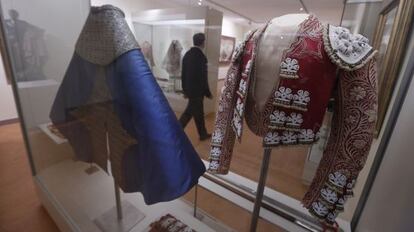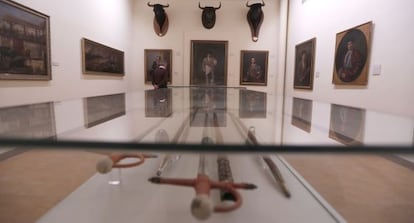Las Ventas: bringing bullfighting’s present and past together
Madrid bullring’s library and museum offer a singular glimpse into the practice’s history


In 1875, two of the most important Spanish journalists of the 19th century, José Ortega Munilla and Miguel Moya, founded a newspaper called El chiclanero, which specialized in bullfighting and was meant for distribution two hours after each fight.
These two giants of the reporting world, then aged only 19, wrote their columns right after each corrida, then ran to a nearby printing press, waited for the newspapers to get printed, and with the ink still fresh, raced back to hand them out in the taverns around the bullring, then near Puerta de Alcalá.
Today, the library at Madrid’s Las Ventas bullring houses one of the most complete collections of this publication. But this is not the only historical gem kept at the arena, which is aiming to become a cultural center for all things bull-related.
The museum contains iconic items such as the outfit worn by Manolete on the day he was gored to death
Carlos Abella, managing director of the Madrid Regional Center for Bullfighting Studies, and head of Las Ventas, sums up the cultural relevance of this industry with a phrase attributed to the son of one of those two reporters, the renowned philosopher José Ortega y Gasset. “The history of bullfighting is so closely linked to the history of Spain that the latter cannot be understood without understanding the former.”
Las Ventas’ bullfighting museum, the Museo Taurino, has been closed for nine months, but is about to reopen with a 125-meter extension – construction work is over, but one final city license is still pending. In the meantime, the site’s library, inaugurated in 2012 with 3,000 volumes, is constantly receiving new material.
The bulk of the archives is made up by a donation from the family of bullfighting reporter Celestino Espinosa, who wrote for the daily Arriba in the postwar years under the pseudonym R. Capdevila. One of the gems included in this collection is a book sent to Espinosa by his friend, the exiled poet Rafael Alberti, who signed and dated it August 3, 1953 “as a souvenir of those days of our youth in Madrid.”

Carlos Abella, himself a journalist and writer, is an endless source of stories about the old days of bullfighting. “This poster over here is a clear example of Ortega’s phrase,” he explains, standing in front of an enormous sign adorned with the Spanish republican flag and announcing the very first corrida at Las Ventas on June 17, 1931. The event had a starting time of 4.30pm and eight fights were scheduled for that day, compared with the six normally held these days.
The bullfight was organized by the city of Madrid, which promised to donate the proceeds to “a fund to remedy the crisis caused by blue-collar unemployment.”
But the new ring, which had replaced the old one at the site where the Palacio de los Deportes now stands, had just barely been completed; it was still surrounded by little more than mud, and had no public transport links. Back then, Las Ventas was right on the edge of the city.
“There was practically a mutiny. They opened it and had to shut it down again. But once again, the history of Spain is linked to the history of bullfighting because the official inauguration was pushed forward after the Second Republic was proclaimed,” explains Abella.
The ring also contains iconic items that serve as a reminder that death is always hovering over this place. Among them is the outfit worn by famous bullfighter Manolete when he died in the ring at Linares in 1947, gored by a 495-kilogram bull named Islero. Another display case shows the suit that once belonged to Juanita Cruz, a pioneer of female bullfighting, who debuted at Las Ventas on April 6, 1936, just before the Civil War broke out. She was forced into exile because Franco banned women from becoming bullfighters, and died in Madrid in 1981.
Abella notes that Juanita Cruz lies buried in La Almudena cemetery, where her tombstone bears an epitaph that settles old scores with those who kept her away from the ring: “Despite the harm done to me by those responsible for bullfighting’s mediocrity in the 1940s and 50s, three cheers for Spain!”
Tu suscripción se está usando en otro dispositivo
¿Quieres añadir otro usuario a tu suscripción?
Si continúas leyendo en este dispositivo, no se podrá leer en el otro.
FlechaTu suscripción se está usando en otro dispositivo y solo puedes acceder a EL PAÍS desde un dispositivo a la vez.
Si quieres compartir tu cuenta, cambia tu suscripción a la modalidad Premium, así podrás añadir otro usuario. Cada uno accederá con su propia cuenta de email, lo que os permitirá personalizar vuestra experiencia en EL PAÍS.
¿Tienes una suscripción de empresa? Accede aquí para contratar más cuentas.
En el caso de no saber quién está usando tu cuenta, te recomendamos cambiar tu contraseña aquí.
Si decides continuar compartiendo tu cuenta, este mensaje se mostrará en tu dispositivo y en el de la otra persona que está usando tu cuenta de forma indefinida, afectando a tu experiencia de lectura. Puedes consultar aquí los términos y condiciones de la suscripción digital.
Últimas noticias
Maduro pleads not guilty before the federal court in New York: ‘I am still the president of Venezuela’
A new test can detect Alzheimer’s from a finger prick
UN team enters Sudanese city of El Fasher after paramilitary massacre: ‘It’s like a ghost town’
A recipe for resistance: Indigenous peoples politicize their struggles from the kitchen
Most viewed
- Gilles Lipovetsky: ‘If you want to live better and fall in love, take Prozac, don’t look to philosophy’
- Alain Aspect, Nobel laureate in physics: ‘Einstein was so smart that he would have had to recognize quantum entanglement’
- Alvin Hellerstein, a 92-year-old judge appointed by Bill Clinton, to preside over Maduro’s trial in New York
- Maduro’s downfall puts China’s relationship with Venezuela to the test
- Why oil has been at the center of Venezuela-US conflicts for decades








































